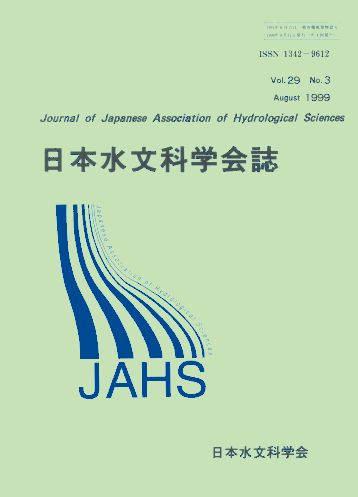
- Issue 4 Pages 177-
- Issue 3 Pages 111-
- Issue 2 Pages 39-
- Issue 1 Pages 1-
- |<
- <
- 1
- >
- >|
-
Seiji HORIUCHI, Maki WATANABE, Koichi KITAOKA1999 Volume 29 Issue 3 Pages 111-122
Published: 1999
Released on J-STAGE: January 07, 2019
JOURNAL FREE ACCESSTurfan and Jyungar basins which have some closed salt lakes are typical closed basins in Xinjian district in western China. A research of water quality was conducted to make clear the groundwater flow in arid and semi-arid zones. The absolute quantity of ions in groundwater, river water and lake water rapidly increases as they flow into the basin and the maximum value was observed at the lake which located in the central part of the basin. The salinity also increases gradually from the foot of mountain to Ayding Lake. The dissolved substances of surface water and groundwater are composed of Ca2+, Mg2+, Na+ and K+, and gradually change from Carbonate Hardness type to Non Carbonate Alkali type according to the increase of salt content. Na+ and Mg2+ increase in accordance with the salt increase and anion changes from HCO3->SO42->Cl- type to SO42->Cl->HCO3- type as pointed out by Scholar (1959) and Langbein (1961). HCO3- dissolution decreases and precipitates as salt increases. NaCl and MgCl2 increases in lake water.
The lowering of lake water level is observed in some closed lakes, such as Lake Aibir and Lake Ayding. Because of recent increase of precipitation and air temperature, it’s hard to consider that the climatological change is a element of the water level lowering. It is caused by artificial influences such as remarkable demand for irrigation and domestic use as pointed out by Yang Chuande (1993).
Limnological research on Selim Lake which is deepest lake in this area (86.9m) was carried out in August, 1997 and leads the following results. The water level dose not change largely, which is different from other salt lakes such as Ayding and Aipi Lake. And the high value in salinity is not observed like another lakes. From the view point of thermal stratification and water quality profile, the Lake Selim is classified as a holomictic and dimictic lake. The transparency is about 7-7.5 m, not so high value as an oligotrophic lake.
View full abstractDownload PDF (4362K)
-
Takeshi HAYASHI, Atsunao MARUI, Masaya YASUHARA1999 Volume 29 Issue 3 Pages 123-138
Published: 1999
Released on J-STAGE: January 07, 2019
JOURNAL FREE ACCESSRishiri Island, located in the northern end of Japanese Islands, is an independent volcanic island and famous for the submarine groundwater discharges. From a viewpoint of hydrology, the island is quite asymmetry. Many surface water (springs, rivers and lakes) exists on the eastern side of the island, whereas little surface water on its western side. This difference is thought to be caused by the geologic asymmetry of the basement rocks.
Major elements in the samples of precipitation, surface water, groundwater and submarine spring water were analyzed to make clear the groundwater flow system of the island. Sea water transported by wind was mixed with the rain water. The inland water was blended with the rain water and the dissolved ions from the rocks. The surface water was strongly affected by the salty rain water and sea salt particles directly transported by wind. Submarine spring water is considered to be composed of almost fresh-and-pure groundwater.
View full abstractDownload PDF (5946K) -
Jong-Kwan PARK1999 Volume 29 Issue 3 Pages 139-148
Published: 1999
Released on J-STAGE: January 07, 2019
JOURNAL FREE ACCESSQuick response of groundwater discharge to a heavy rain storm is a serious problem in Korea. An undisturbed soil-column experiment was conducted to consider the mechanism of rapid groundwater discharge during storm event in a weathered granite basin in Korea. The column was filled with undisturbed layered soil which represents the granite basin, and both precipitation and groundwater level were controlled. The layered structure was effective to store the infiltrated water on a boundary between the soil layers, and the amount of stored water was sufficient to increase the pore air pressure. The increased pore air pressure pushed out the groundwater, and this induced the rapid groundwater discharge. This phenomenon was observed only when the precipitation intensity was more than 40 mm/h and/or the upper soil layer was saturated with rainwater.
View full abstractDownload PDF (3619K)
- |<
- <
- 1
- >
- >|